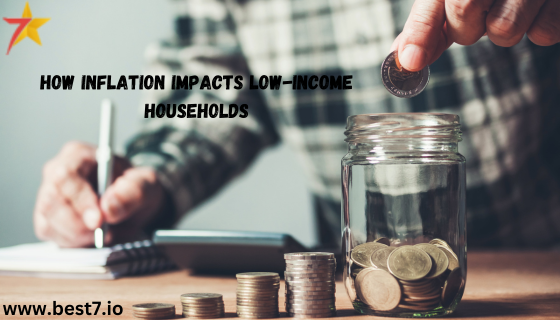
Inflation is arguably one of the most urgent issues faced by low-income households today. With rising prices, these social groups are affected more than other populations as they struggle to secure their quality of life and financial stability.
As inflation goes on the rise, especially in the light of the recent wave of economic disruptions, the effects on the vulnerable population should be discussed more extensively. The present analysis, in particular, will explore the implications that inflation has specifically for low-income households and, based on previous case studies, identify the issues that they are likely to face in the future.
The Impact of Inflation on Low-Income Households
The implications of inflation are bound to be the strongest for the poor and low-income population in the United States. The fact that the affected population has to work within a very limited budget framework restricts the ability of the low-income population to respond to the rising prices adequately.
As of today, inflation has picked up rates not registered for decades, with essentials being rendered inadequate for the poor. As a result, it is suggested that inflation will slow to 3.5 percent; nevertheless, even though relatively stable inflation rates may sound advantageous, they mean that the situation for the low-income population will hardly improve.
COVID-19’s Impact as an Example of Inflation’s Burden on Low-Income Families
The disaster triggered by the COVID-19 pandemic can be viewed as a great illustration of the impact that inflation has on the low-income population. In the current environment, prices on all of the most vital goods, in particular foods and housing, receive an incredible boost. To be more precise, in 2021, food at home was 6.4 percent more expensive than in 2020, thus becoming unaffordable for the low-income population. This inflation hits the hardest when it comes to basic needs like food, which many low-income households struggle to afford.
Critical Aspects of Inflation Affecting Essential Needs
Rising Prices on Essential Goods:
As a direct effect of inflation, low-income households have to allocate a significant amount of their income to essential goods, such as food and housing, limiting their spending in other areas.
Hunger:
The increase in food prices has led to heightened food insecurity. Rising inflation rates could increase the percentage of food-insecure households to 12% by 2025, compared to 10% in 2021.
Housing, Healthcare, and the Growing Economic Disparity
Housing Problem:
The lack of affordable housing continues to burden low-income households, with many spending over 50% of their income on rent. This large financial drain diminishes the funds available for other basic needs, such as healthcare and education.
Healthcare Constraints:
Inflation leads to rising healthcare costs, making access more difficult for low-income households. Kemper projects that healthcare expenses will rise by 8% by 2024, further straining low-income families’ finances.
Economic Disparities:
Inflation exacerbates economic inequality, particularly for low-income households lacking the liquid assets to offset rising costs. This disparity can perpetuate poverty across generations, trapping low-income families in a cycle of economic disadvantage.
Budget Constraints and the Impact on Community Support
Budget Constraints:
Higher inflation rates pressure the budgets of low-income households, intensifying unemployment challenges and raising the need for financial literacy to manage daily household security.
Pressure on Community Support Systems:
Inflation affects income sources, including employment among lower-income families, increasing the strain on community support and welfare programs, which are expected to accommodate more families by 2026.
Broader Implications of Inflation on Quality of Life
In general, the cumulative implications of inflation for low-income households extend beyond financial stress to a diminished quality of life, particularly for those lacking resources to maintain basic living standards.
- Mental Health Impact: The financial pressures from inflation can significantly increase stress, potentially leading to broader mental health issues.
- Access to Education: Inflation is likely to push 15% of low-income households to reduce spending on education, which could have long-term effects on children’s personal and career development.
The Risk of Long-Term Social and Economic Challenges
- Child Development Restrictions: Continuous economic stress and limited resources can impact children’s early development, affecting future opportunities and life quality.
- Increased Crime Rates: Regions with higher inflation rates often see an increase in crime, as families face more financial difficulties.
- Social Isolation: Economic pressure can lead to social withdrawal, with an estimated increase in social isolation by 2026.
- Lost Savings Opportunities: Rising inflation prevents many from saving, with projections indicating that by 2027, 60% of low-income households will have no emergency funds.
Changing Consumer Behavior Due to Reduced Spending Power
The reduction in spending power due to inflation often causes families to switch to lower-quality, inexpensive goods, which can have lasting negative health impacts.
Government and Economic Policies: Addressing Inflation’s Effects on Low-Income Households
Various government and economic policies can help address the challenges inflation brings to low-income households. Key policies include:
- Welfare Programs: By 2025, welfare program budgets are expected to increase by 20% to support low-income families.
- Minimum Wage Increases: Raising the minimum wage to $15 per hour by 2026 in several states could help low-income families cope with inflation.
Affordable Housing and Food Security Programs to Assist Low-Income Families
Affordable Housing Policies: By 2025, government-backed affordable housing construction will see an increase to lower housing costs.
Food Security Programs: These will play an essential role as food prices rise, potentially aiding 50% more families by 2026.
Future Projections for Low-Income Households Facing Inflation
As inflation impacts low-income households, future projections indicate ongoing challenges with food and housing. Despite a potential stabilization of inflation at 3.5% by 2026, living standards for low-income families may continue to decline, requiring enhanced economic policies and community support.
Economic policies, alongside community support systems, will play a vital role in assisting low-income households to overcome the financial hardships posed by inflation.












